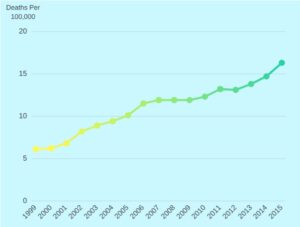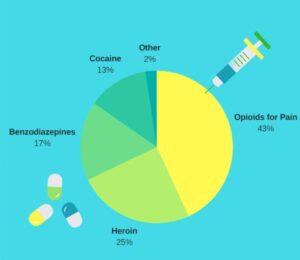The problem has been bubbling beneath the surface of public awareness for years but it’s just become too big to ignore. It might be the biggest problem our country is currently facing. The number one cause of death for people under 50 years old isn’t violence, it isn’t infectious diseases, and it isn’t even texting and driving; it’s overdose. In 2015 alone, there were 52,000 overdose deaths in the US and that number has been exponentially growing for years.
To better understand this problem, the Centers for Disease Control and Prevention (CDC) has recently released a study comparing the overdose death rates in rural and metropolitan areas. The study reveals new insight into the fastest growing areas of drug overdose in the country and may tell us how to best move forward in the fight against addiction. However, to understand the overdose epidemic, it’s important to understand how fast the problem is growing.
The Exponential Rise
Something changed in the late 20th century. From 1980 to the mid-1990s, drug overdoses were a problem, but there were always fewer than 10,000 deaths per year. Granted, that sounds like a lot. No one should lose loved ones to drug use. However, the numbers were always dominated by other causes of death like car accidents and the AIDS epidemic. But, as we neared the new millennium, drug use began its sinister upward trend.
According to the New York Times, overdose death rates broke 10,000 by 1995, it broke the gun deaths record by 2010, it surpassed peak HIV related deaths by 2014, and in 2015, more lives were taken by overdose than car accidents had ever claimed in a single year.
Maintaining an opioid addiction is now the deadliest thing you can do.

[Line graph showing increase using this data.]
This unprecedented rise in overdose deaths started with cocaine in the late 80s and early 90s but shifted to opioids around the turn of the century. Opioids are a class of drugs that includes heroin, prescription pain relievers like Percocet, and other illicit opioids. The risk for addiction in opioids is high and has led to the spike in overdose rates to be dubbed the opioid epidemic.
From Toothaches to Overdose
How does wisdom tooth removal lead to an overdose on an opioid 100 times stronger than morphine? The answer is in the way that all three of the types of opioid (prescription, traditional heroin, and illegally produced opioids) work together to make a deadly combination. An opioid user may get a prescription from a doctor for anything from a dental procedure to a broken femur.
Now, most people will take their prescription as needed and never have a problem—only between 8 and 12 percent of people using opioids for chronic pain have problems with dependency. However, if a person has any of the risk factors for addiction like a genetic predisposition or environmental factors, they might develop an addiction. Nearly 80 percent of heroin users start with prescriptions obtained both legally and illegally.
Becoming addicted to prescription opioids is very difficult to maintain. Pills are expensive and hard to get. As a result, many turn to heroin, which is inherently dangerous. Since the drug is often mixed with other substances, it’s difficult to know how powerful it is until you try it. Users will often get used to a dosage and then overdose when they take an unusually pure hit.
Heroin addiction has you chasing the feeling of that first high. Subsequent hits of the drug are never the same. However, users and dealers are starting to use illicitly produced powerful opioids like fentanyl to increase the intensity of the experience. Fentanyl is 50 to 100 times more powerful than morphine and nothing to be trifled with. Some users may not know their heroin has fentanyl in it until it’s too late.
Which States Have the Highest Overdose Rates?
The opioid epidemic has seen unlikely victims, including the daughter of a drug enforcement police officer. Because addiction can start in the streets or at your local pharmacy, overdose may be closer to home for most people than you think.
When you think of drug problems, you might assume the epicenters of this epidemic are in urban areas like New York City, Miami, Chicago, and Los Angeles. The states with sprawling metropolises must be the hardest hit by the opioid epidemic, right? While the CDC reports high numbers of overdose deaths in urban areas, the number one state isn’t the most highly or densely populated.
The current epicenter for overdose death rates seems to be the Midwest and Northeast. West Virginia has the highest rate, with 41.5 deaths per 100,000 people. New Hampshire, Kentucky, Ohio, and Rhode Island make up the rest of the top five. Ohio has the most deaths in the top five with 3,310 in 2015 alone. By comparison, New York had 2,754 overdose deaths in the same year. That means Ohio beats states with much larger populations.

[State heat map showing overdose intensity by state using this data. Example here.]
Smaller, less densely populated states seem to be bearing the brunt of the overdose storm. The CDC study looking at metropolitan areas and nonmetropolitan areas offers some insight into the epidemic outside big cities.
Overdose Death Rates Rise in Non-Metropolitan Areas
The CDC reviewed data collected by the National Survey of Drug Use and Health and the National Vital Statistics System Mortality and compared the trends in large metropolitan areas and nonmetropolitan areas. They were able to confirm that drug overdose statistics have risen dramatically over the past two decades in both rural and urban areas.
Overall, there were more overdose deaths in metropolitan areas, by far. The study reported, “In 2015, approximately six times as many drug overdose deaths occurred in metropolitan areas than in nonmetropolitan areas.” However, that statistic is to be expected. With a higher population in both size and density, drug use can spread quickly to more people. The increasing rates per 100,000 people is where the study diverges from the predictable.
In 1999, the rates were heavier in metropolitan areas and continued to increase in both types of areas. They grew along these lines until 2004 when they started to change. Nonmetropolitan areas began to experience more and more overdose deaths.
In 2015, nonmetropolitan areas overtook big cities with a slightly higher rate at 17.2 deaths per 100,000 and metros at 16.2. It may seem like a small shift, but it’s a significant problem. Smaller towns, suburbs, and rural areas aren’t as well equipped to deal with overdose crisis. This problem can lead to situations like the ones we are seeing in Ohio, where so many people are dying from drug overdoses that the morgues are at capacity.
According to a National Institute of Health Study in 2014, four possible factors contribute to the rise in drug use in rural areas:
- An increase in sales of opioid prescriptions in rural areas that has lead to broader availability through illegal markets.
- A weakened economic infrastructure due to young people moving away from rural areas. The remaining young adults tend to have high risk factors for drug use, including isolation and poor economic conditions.
- Tight-knit social networks facilitate faster distribution of drugs and drug use.
- Economic stressors caused by unemployment and industrial shifts increase risk factors for drug use.
Though, in rural areas, the rates are the lowest, as the CDC report says, “the consequences of use appear to be higher.”
The Cause of Rising Overdose
While the opioid epidemic is gaining ground, under-equipped areas are struggling. The report points out a possible reason: “Access to substance abuse treatment services is more limited in rural areas.” The CDC has recommended that health care delivery systems and emergency services should be strengthened in rural areas to answer the growing trend.
Overdose can be caused by many different illicit and prescription drugs when abused. Because of the opioid epidemic, heroin is the leading cause of overdose. Pain relieving opioids are the deadliest drug with heroin following close behind.

[Pie chart showing causes of overdose deaths.]
How Fentanyl is Killing the Nation
Powerful opioids like fentanyl are a significant cause of opioid-related death. Fentanyl is cheaper and easier to make than heroin, so it is used as an adulterant to increase profits. However, unknowingly taking a dose of heroin that’s cut with fentanyl can quickly lead to overdose.
If you or someone you know is in the throes of an opioid addiction, the next bag of heroin could be the last.
It’s no understatement that this new drug is a massive contributor to the recent spike in overdoses. With the death tolls more than quadrupling between 2014 and 2015, those numbers are only going higher. Each day more than 55 lives are claimed by fentanyl alone.
That’s more than one death every half hour.
Don’t become a statistic, the solution is treatment. By purging the drug from the system and tackling the thoughts, emotions, and behaviors that lead to drug abuse, we can help make a stand against this growing epidemic and start healing the nation one person at a time.
